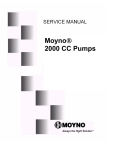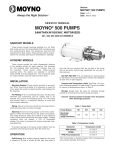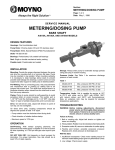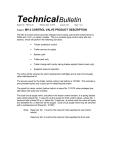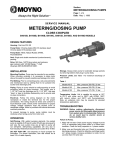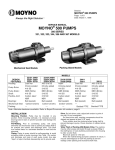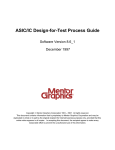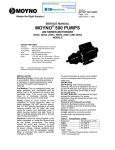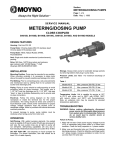Download 500 Pump (Service Manual - 600 Series: 60301,61001,62201
Transcript
Section: ® MOYNO 500 PUMPS Page: 1 of 6 Date: March1, 1998 SERVICE MANUAL MOYNO® 500 PUMPS 600 SERIES 60301, 61001, 62201, 63301, 65501, 60311, 61011, 62211, 63311, AND 65511* MODELS DESIGN FEATURES Cast iron Heavy duty chrome plated AISI 416 stainless steel Pump Stator: NBR (Nitrile) Shaft: AISI 416 stainless steel Bearings: Prelubricated, fully sealed ball bearings Seal: Mechanical or packing Flexible Joint: Prelubricated and sealed *Packing Models available through retrofit kit. See page 6. Note: Alternate elastomers available. Refer to Repair/Conversion kit numbers. page 6. Housing: Pump Rotor: INSTALLATION Mounting. Provide the proper alignment between the pump and drive by mounting both to a common flat base. Pump may be mounted in any position. When mounting vertically, it is necessary to keep bearings above seals to prevent possible seal leakage into bearings. Loosen screws on body support and stator support to rotate pump to desired position. Pre-Wetting. Prior to connecting pump, wet pump elements and mechanical seal or packing by adding fluid to be pumped into suction port. Turn shaft over several times in a clockwise direction when viewed from the shaft end to work fluid into pump elements. Piping. Piping to pump should be self-supporting to avoid excessive strain on pump housings. See Table 1 for suction and discharge port sizes of each pump model. Use pipe ‘dope” or tape to facilitate disassembly and to provide seal. Drive. On belt driven units, adjust belt tension to point of non-slip. Do not overtighten. On direct drive units, coupling components should be aligned and spaced at least 1/16” apart. Pump rotation must be clockwise when facing shaft. Check direction of rotation before startup. Maximum speed is 1750 rpm. Water Flush of Packing (Packing Models Only). The packing may be either grease lubricated through a grease fitting in the stuffing box or have plumbing connected to the housing to allow a water flush. When the material being pumped is abrasive in nature, it may be advantageous to flush the packing to prevent leakage under packing and excessive shaft wear. Clean water can be injected through a 1/8” NPT tapped hole that normally houses the grease fitting for lubricating the packing. The water can be permitted to leak axially along the shaft in either direction. OPERATION Self-Priming. With wetted pumping elements, the mechanical seal model pump is capable of 15 feet of suction lift when operating at 1750 rpm with pipe size equal to port size. The packing model is capable of 25 feet of suction lift. DO NOT RUN DRY. Unit depends on liquid pumped for lubrication. For proper lubrication, flow rate should be at least 10% of rated capacity. Pressure and Temperature Limits. See Table 1 for maximum discharge pressure of each model. Unit is suitable for service at 10° to 160°F with NBR (Nitrile), and to 210°F with EPDM (Ethylene-Propylene-Diene Terpolymer) elastomers. Storage. Always drain pump for extended storage periods using pipe plug in suction housing. Table 1. Pump Data Pump Model Suction Port (NPT) Discharge Port_(NPT) Discharge Pressure (psig) *Minimum Starting Torque (IN-LB) 60301 60311 61001 61011 62201 62211 63301 63311 65501 65511 3/4 3/4 3/4 1-1/4 1-1/4 1/2 3/4 3/4 1-1/4 1-1/4 600 600 300 150 60 95 180 90 70 60 *Based on water at ambient temperature. Page 2 TROUBLE SHOOTING WARNING: Before making adjustments, disconnect power source and thoroughly bleed pressure from system. Failure to do so could result in electric shock or serious bodily harm. Failure To Pump. 1. Belt or coupling slip: Adjust belt tension or tighten set screw on coupling. 2. Wrong rotation: Rotation must be clockwise when facing shaft. 3. Excessive suction lift, vacuum or obstruction in suction piping. 4. Flexible joint broken; possible excessive pressure: Replace joint, check pressure at discharge port. Will Not Start. 1. Insufficient horsepower: Check motor starting torque for minimum model starting torque given in Table 1. 2. Low voltage: Check power supply. Pump Overloads. 1. Excessive discharge pressure: Check discharge pressure for maximum rating given in Table 1 above. Check for obstruction in discharge pipe. 2. Excessive temperature: Check fluid temperature for a maximum of 160°F. 3. Belt or coupling slip: Check pressure at discharge port. 4. Loose bond in stator: High temperature and caustics will cause bond between rubber and tube to fail. Replace stator, check fluid temperature and pressure at discharge port. 5. Fluid viscosity too high: Recommended maximum RPM. Viscosity CP 1-300 300-1,000 1,000-2,000 2,000-5,000 5,000-10,000 10,000-20,000 6. Limit RPM 1750 1200 700 350 180 100 Motor connected incorrectly: Motor wired for 230 VAC, connected to 115 VAC service. Noisy Operation. 1. Starved suction: Check fluid supply, length of suction line, and obstructions in pipe. 2. Bearings worn: Replace parts; check alignment, belt tension, pressure at discharge port. 3. Broken flexible joint: Replace part; check pressure at discharge port. 4. Insufficient mounting: Mount to be secure to firm base. Vibration induced noise can be reduced by using mount pads and hose on suction and discharge ports. Poor Performance. 1. Low pressure; worn stator: Replace stator: check for excessive abrasive material in fluid, check for run dry condition. Mechanical Seal Leakage (Mechanical Seal Models Only). 1. Leakage at startup: If leakage is slight, allow pump to run several hours to let faces run in. 2. Persistent seal leakage: Faces may be cracked from freezing or thermal shock. Replace seal. Packing Leakage (Packing Models Only). 1. Leakage at startup: Adjust packing as outlined in maintenance instructions. Note: Slight leakage is necessary for lubrication of packing. 2. Persistent leakage: Packing rings and/or shaft may be worn. Replace parts as required. Pump Will Not Prime. 1. Air leak on suction side: Check pipe connections. Suction lift over 15 ft. will cause seal faces to open. 2. Defective mechanical seal: Inspect and repair as necessary. MAINTENANCE General. These pumps have been designed for a minimum of maintenance, the extent of which is routine lubrication and adjustment of packing. The pump is one of the easiest to work on in that the main elements are very accessible and require few tools to disassemble. Packing Lubrication (Packing Models Only). The zerk fitting on the top of the packing housing leads to the lantern ring halves in the mid-section of the packings. At least once a week, inject a small quantity of good quality grease, such as MPG-2 Multi Purpose Grease (DuBois Chemical), or equivalent, into the zerk fitting to lubricate the packings. Packing Adjustment (Packing Models Only). Packing gland attaching nuts should be evenly adjusted so they are little more than finger tight. Overtightening of the packing gland may result in premature packing failure and possible damage to the shaft and gland. When the packing is new, frequent minor adjustments are recommended for the first few hours of operation in order to compress and seat the packing. Be sure to allow slight leakage for lubrication of packing. When excessive leakage can no longer be regulated by tightening the gland nuts, remove and replace the packings in accordance with the DISASSEMBLY and REASSEMBLY instructions. The entire pump need not be disassembled to replace the packings. Bearing Lubrication. The prelubricated, fully sealed bearings do not require additional lubrication. Page 3 PUMP DISASSEMBLY PUMP ASSEMBLY WARNING: Before disassembling pump, disconnect power source and thoroughly bleed pressure from system. Failure to do so could result in electric shock or serious bodily harm. 1. Disconnect power source. 2. Remove suction and discharge piping. 3. Reducer (9) may be removed from stator (21) by unscrewing in a counter-clockwise direction (RH thread). 4. Remove stator support screws (112B) and remove top half of stator support(s) (38). 5. Stator (21) may be removed from suction housing (2) by unscrewing in a counter-clockwise direction (RH thread). Use a strap wrench on stator to avoid crushing with a pipe wrench. Pull stator (21) from rotor (22). To assist removal of stator, hold shaft (26) from turning and turn stator clockwise when facing suction housing after disengaging thread. 6. Remove screws (112) holding suction housing (2) to bearing housing (1). Remove suction housing and suction housing gasket (83). 7. The rotor (22) and flexible joint (24) may be removed using the following procedure (do not bend joint more than 15 degrees). a. Remove rotor (22) from flexible joint (24) by using a punch to remove rotor pin (46). Support joint while removing pin. Note: On Model 603 only, remove adaptor (264) from rotor by turning in a counter-clockwise direction (RH Thread.) b. Remove joint (24) from shaft (26) by using a punch to remove shaft pin (46). 8. Mechanical Seal Models. Carefully slide mechanical seal (69) off shaft (26). Carefully pry seal out of bearing housing (1). If any parts of mechanical seal are worn out or broken, the complete assembly should be replaced. Seal components are matched parts and are not interchangeable. 9. Packing Models. Remove bolts attaching packing gland housing (3) to bearing housing (1) and remove packing gland housing. Disconnect drive shaft extension (27) by using a punch to remove shaft pin (46). The packing (42) can be removed without removing the shaft (27) using the following procedure: a. Remove gland bolts (47). b. Slide gland (41) away from packing (42). c. Pull out packing (42) and lantern ring halves (57) using a packing-removing tool. Note: If shaft (27) has been removed, the packing can be removed easily by pushing out from pump side of packing gland housing (3). 10. The bearings (29 and 30) and shaft (26) assembly can be removed from bearing housing (1) after snap ring (66) has been removed. To remove the shaft assembly, lightly tap the shaft at the flexible joint connection end using a block of wood to protect the shaft. The bearings may be pressed off the shaft. 1. Press radial bearing (29) and thrust bearing (30) on shaft (26), and locate slinger ring (77) on the shaft near the radial bearing. Note: When replacing bearings, always press on the inner race when assembling to shaft, and on the outer race when pressing bearings into the housings. Press shaft assembly into bearing housing (1) 2. securing with snap ring (66). 3. Mechanical Seal Models. Install mechanical seal (69) using the following procedure: a. Clean and oil sealing faces using a clean light oil (not grease). Caution: Do not use oil on EPDM parts. Substitute glycerin or soap and water. b. Oil the outer surface of the seal seat, and push the assembly into the seal bore in the bearing housing (1), seating it firmly and squarely. c. After cleaning and oiling shaft, slide the seal body along the shaft until it meets the seal seat. d. Install seal spring and spring retainer on shaft. 4. Packing Models. Install packing before installing shaft assembly using the following procedure: a. Lubricate each individual ring of packing (42) with a grease that is insoluble in the fluid being pumped. b. Individually assemble each ring of packing loosely in the stuffing box of the packing gland housing (3). Seven rings of 1/4” square plus 2 lantern ring halves required—assemble with 3 rings, 2 lantern ring halves (57), followed by 4 rings. Stagger split in rings. c. Loosely install packing gland (41) in packing gland housing (3) using gland bolts (47). d. Attach drive shaft extension (27) to drive shaft (26) by installing pin (46). Support shaft during installation. e. Install slinger ring (77) on drive shaft extension (27). f. Slide packing gland housing (3) on drive shaft extension, and attach to bearing housing with bolts (112). 5. The flexible joint (24) and rotor (22) may be installed using the following procedure (do not bend joint more than 15 degrees): Note: On model 603 only, pin adaptor (264) to flexible joint (24) with rotor pin (46), then thread rotor (22) on adaptor by turning clockwise (RH Thread.) a. Pin flexible joint (24) to shaft (26) using shaft pin (46). b. Pin rotor (22) to joint using rotor pin (46). Support joint while installing pin. 6. Secure suction housing gasket (83) and suction housing (2) to bearing housing (1) using lock washers (215) and screws (112). 7. Screw reducer (9) on stator (21) in a clockwise direction (RH thread). Note: Apply pipe “dope” on all pipe threads before assembly. Page 4 8. Lubricate rotor (22) surface to assist installation of stator (21). Slide stator on rotor, using stator support(s) (38) as a guide, and screw into suction housing (2) by turning clockwise (RH threads). An additional assist in installing stator is to lock the shaft from turning and rotate the stator counterclockwise while pushing towards suction housing. Care should be taken to insure that flexible joint does not bend more than 15 degrees. 9. Secure top and bottom halves of stator support (38) together using screws (112B). Model 603 requires stator support bushings (71) between stator and stator support. 10. Proceed as in installation instructions. WARNING: Replace belt or coupling guards before reconnecting power. Page 5 PARTS LIST Item No. Description 1 2 ‡3 9 *21 *22 24 26 ‡27 29 30 37 38 ‡41 ‡42 46 ‡47 ‡57 66 @69 71 77 *83 @112 ‡112 112A 112B Bearing Housing Suction Housing Packing Housing Reducer Stator Rotor Flexible Joint Drive Shaft Drive Shaft Extension Radial Bearing Thrust Bearing Body Support Stator Support Packing Gland Packing Rotor Pin/Shaft Pin (3 req.) Gland Bolt (2 req.) Lantern Ring Half (2 req.) Snap Ring Mechanical Seal Stator Support Bushing (2 req.) Slinger Ring Suction Housing Gasket Screw (4 req.) Screw (8 req.) Screw (2 req.) Screw (2 req.) ‡115 162 202 @215 ‡215 261 264 265 Zerk Fitting Support Shim Shaft Key Lock Washer (4 req.) Lock Washer (8 req.) Pipe Plug Rotor Adaptor Stator Adaptor Pump Model Number 60301 61001 60311 61011 62201 62211 63301 63311 65501 65511 330-3552-000 330-2112-001 320-6110-000 320-6108-006 330-4606-000 330-2112-003 ‡340-2368-000 320-1414-004 320-5466-006 320-3902-004 330-4607-000 330-4608-000 320-3944-000 330-3553-000 ‡330-4586-000 630-0503-051 630-0503-051 330-3554-000 330-4461-000 ‡320-0003-004 ‡340-3396-008 320-4486-003 ‡619-1530-241 ‡320-6585-000 320-2794-000 @320-3945-000 320-6539-000 330-2608-002 330-4609-000 330-0413-000 320-5306-000 320-6384-000 320-3028-000 @619-1520-161 ‡619-1520-161 619-1530-281 @619-1520-163 ‡619-1520-363 619-1530-241 ‡320-2503-001 ‡320-0077-003 611-0030-200 @623-0010-401 ‡623-0010-401 610-0120-021 320-6388-000 320-6389-001 ‡ Use only on Packing Gland Models (Model No. ends with 11) @ Use only on Mechanical Seal Models (Model No. ends with 01). * Recommended spare parts. 320-6539-000 330-2612-001 330-4610-000 Page 6 REPAIR/CONVERSION KIT NUMBERS (EPDM ELASTOMER) Item No. – 21 69 24 Description Kit No. • Stator • Seal • Joint Pump Models 603 610 622 633 655 311-9129-000 320-6470-006 311-9130-000 320-6471-006 311-9131-000 320-6472-004 320-6380-000 320-6523-000 311-9132-000 320-6473-002 311-9133-000 320-6474-001 REPAIR/CONVERSION KIT NUMBERS (ABRASION RESISTANT SEAL) Description All Mechanical Seal Models Only NBR Kit No. EPDM Kit No. 320-6505-000 320-6506-000 NBR = Nitrile EPDM = Ethylene Propylene Diene Terpolymer REPAIR/CONVERSION KIT NUMBERS (PACKING GLAND) Item No. – 3 27 41 42 46 47 57 112 115 215 All Packing Gland Models Description Kit No. • Packing Housing • Drive Shaft Extension • Packing Gland • Packing Set • Shaft Pin (3 req.) • Gland Bolt (2 req.) • Lantern Ring Half (2 req.) • Screw (4 req.) • Zerk Fitting • Lock Washer (4 req.) © 1999 by Moyno, Inc. ® Moyno is a registered trademark of Moyno, Inc. 311-9049-000 340-2368-000 330-4586-000 320-0003-104 340-3351-008 320-4486-003 619-1530-241 320-6385-000 619-1520-161 220-2503-001 623-0010-401 Printed in U.S.A.













